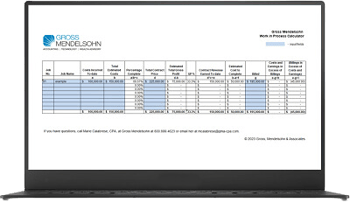A work in process (WIP) schedule is one of the most important financial tools for a contractor—and it may be underutilized. Not only does a WIP schedule give a construction company and project stakeholders insight into a project’s financial performance, but it can help keep a company on track with a project currently in progress.
To ensure your construction company fully leverages WIP’s capabilities, we’ll dive into some basics regarding WIP along with five key tips that will help keep your WIP schedules in good order.
WIP Basics
WIP is generally measured by one of two methods—the percent completion method or the units completed method.
Under the percent completion method, the ratio of costs incurred to total estimated costs is multiplied by the amount of revenue expected to come from the contract. This sum will provide an estimated amount of revenue earned on the job. Let’s walk through an example:
- Your contract is for $10,000
- The project is expected to cost you $6,000
- You have $3,000 of incurred costs
Based on these facts, your revenue earned would be $5,000 ($3,000/$6,000 = 50% of costs incurred; 50% x $10,000 = $5,000 earned revenue). The amount earned is then compared to the amount that has been billed on that contract. If the amount earned is higher than the amount billed, it results in a contract asset on your books (you have done more work than what you have invoiced). If the amount earned is lower than the amount you have billed, then you have overbilled and have a contract liability. Perform this calculation for all open jobs to build out a full WIP schedule.
The units completion method follows a similar logic except the individual deliverables (units) are identifiable. For instance, if you have 20 propane tanks to install, and you’ve installed 10 of them, the project is 50% complete. The math is then the same to determine whether you have a contract asset or liability. However, if you’ve spent 90% of your costs to install 50% of the units, that could be a big problem.
WIP Tips
Now that we’ve covered the basics, here are five helpful tips when completing your WIP schedule.
- The most important input to the WIP schedule is the estimated cost to complete. This input changes over time and places a premium on the ability to accurately estimate remaining job costs. The rest of the numbers are “given,” so the estimated cost to complete can make or break your WIP.
- Understand the users of your WIP schedule. If it is your bonding agent, talk to them to get an idea of what level of detail they like to see and if they have any preferences on how the schedule is presented. For internal users, make sure they understand why it matters and how it can impact the company’s bottom line.
- Update your WIP schedule on a regular basis. Scrambling at year-end to track down project managers to update the estimated cost to complete is a last resort. If you get on a regularly updated schedule, you will have relevant data year-round and can make more informed decisions about your jobs. Outliers will pop off the schedule.
- Watch out for large receivables that are showing on completed jobs, as it could indicate issues with payment or contract disputes.
- Remember to include change orders in the contract cost and estimated cost to complete—this is not a static schedule, it should and will change over time.
Need Help?
The items discussed above were just a few out of the many that should be considered when completing your WIP schedule. If you have questions about your WIP schedule and how to get more out of it, contact us here or call 800.899.4623.


